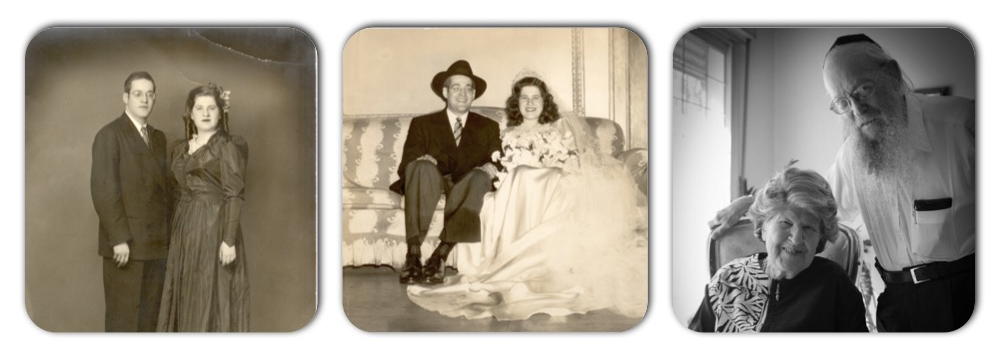Rabbi Yehudah Leib Bistritzky, Provider of Physical and Spiritual Sustenance
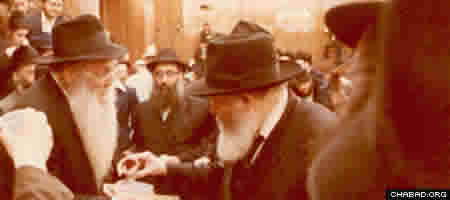 |
| Rabbi Yehudah Leib (“Reb Leibel”) Bistritzky with the Rebbe. |
Rabbi Yehudah Leib (“Reb Leibel”) Bistritzky, 86, a prominent and much loved figure in the Chabad-Lubavitch community and beyond, passed away on May 13. He was more commonly known as “Reb Leibel.”
Reb Leibel escaped Nazi Germany at the age of 12. He subsequently developed a special relationship with the sixth Lubavitcher Rebbe, Rabbi Yosef Yitzchak Schneersohn, of righteous memory, and later also with his son-in-law and successor, Rabbi Menachem M. Schneerson, of righteous memory. He was the proprietor of an iconic kosher food store on Manhattan’s Lower East Side, an early pioneer of the medical emergency volunteer response organization Hatzalah, and the patriarch of a large family whose members have built Jewish institutions across the world.
From Germany to America
Reb Leibel was born in 1926 to Chassidic parents, Mordechai and Shifra Bistritzky, whose families had left Russia following the Communist revolution. They made their home in Hamburg, Germany. During the early decades of the 20th century, the neighborhood known as Grindelhof had grown into a flourishing Jewish community with several synagogues and a Jewish day school—Die Talmud Tora Realschule—attended by the young Leibel from 1936 to 1938. His father was a successful businessman whose company, Scandinavian Corporation Bistritzky & Co., dealt in various kinds of marine oil. As persecution of the Jews intensified, the Nazis took steps to wrest control of the company from his hands, and he decided that the time had come to leave the country.
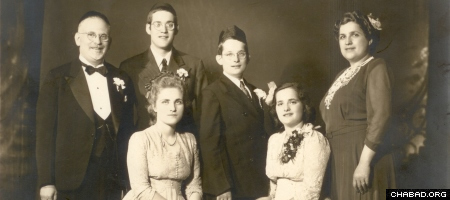
Reb Leibel, second from left, with his family in the 1940s
Mordechai’s business often took him to Rotterdam, the large port city of the Netherlands, as well as other cities in Belgium and Scandinavia. On one such trip, several months before Kristallnacht (“The Night of the Broken Glass”) in November 1938, he sent a telegram to his wife, telling her to take the children and join him on the non-German side of the border. Mordechai then made a brief trip to New York, where he deposited $50,000 with Chase Bank.He returned to Europe with proof of his financial solvency and applied for visas allowing his family to relocate to the United States.
They found temporary refuge first in Antwerp and then Rotterdam. Then, in the summer of 1939, Leibel, his three siblings and his parents boarded the Georgic—a motor liner of the White Star Line—bound for New York.
In America, Mordechai’s business skills flourished, and his sense of responsibility for the physical and spiritual welfare of the Jewish people was awakened. He worked on behalf of European Jews seeking refuge in the United States, and invested time and money to ensure that Jewish children in America would receive a proper Jewish education. Although Mordechai hailed from a family of Boyaner Chassidim, his wife’s family was connected to Lubavitch. He had first met the sixth Lubavitcher Rebbe, Rabbi Yosef Yitzchak Schneersohn, while on holiday in Marienbad, the famous European spa town. When the Rebbe arrived from Europe in March 1940, he found in Mordechai Bistritzky an active and enthusiastic supporter.
Years later, Leibel recalled that first meeting:
“On Purim, 1940, just a few days after the Rebbe had arrived in the United States, my father and mother took the children to the Rebbe’s gathering in the Greystone Hotel in Manhattan. Before the gathering, my father approached Rabbi Eliyahu Simpson, who was charged with the arranging private audiences (yechidut), and asked permission to enter the Rebbe’s presence. The Rebbe gave permission.
“As we stood in the doorway, the Rebbe motioned for us to enter. I saw the Rebbe sitting next to a small table with a chair on either side. At this point my father pointed at me and said, ‘this is my son Yehudah Leib.’ I was then 13 and a half years old. The Rebbe gave me his hand, greeted me with ‘shalom aleichem,’ and looked at me intently. At that moment I felt as if the Rebbe was piercing me with his gaze. In Europe I had met many other chassidic rebbes, but never before had I experienced such a feeling.”
When the Rebbe opened a younger division of the yeshivah Tomchei Temimim Lubavitch, Leibel was among the first students.
A Special Bond
Two of Rabbi Yosef Yitzchak’s daughters, together with their husbands, were still trapped in Europe. His youngest daughter, Shaina, and her husband, Rabbi Menachem Mendel Horenstein, eventually perished in Treblinka. But the middle daughter, Chaya Mushka (Moussia), and her husband, Rabbi Menachem Mendel Schneerson—who would later succeed his father-in-law as the seventh Lubavitcher Rebbe—escaped from Vichy France to Lisbon in the spring of 1941.
While there they had difficulty obtaining passage on a ship bound for New York. Mordechai Bistritzky, however, had obtained passage for his in-laws, Levi and Rechuma Lagovier. They, too, had made their way to France, but it soon became apparent that they would not be able to cross the border into Portugal. It was arranged that the Rebbe’s daughter and son-in-law would take passage in their stead.(The Lagovier couple was later transported from the French internment camp at Drancy to Auschwitz. There is no record of their entering Auschwitz, and they most likely died or were killed during transport.)
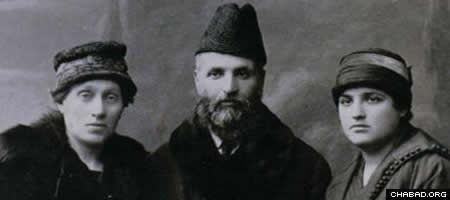
Ruchama, Levi and Shifra Lagovier.
When Rabbi Menachem Mendel and his wife arrived in the United States, these events led to a special bond between them and the Bistritzky family. Leibel recalled that Rabbi Menachem Mendel and Rebbetzin Chaya Mushka would sometimes visit his parents in their home, where they would converse over tea or coffee. “My mother and Rebbetzin Chaya Mushka would converse in Russian, and the Rebbe would talk with my father. Of course I never sat down near them; instead I would politely say ‘good evening,’ and retire to my room. But I remember the excitement till today.”
The students of the Lubavitch yeshivah studied on the ground floor of 770 Eastern Parkway, the now famous headquarters of Chabad-Lubavitch in Brooklyn. The offices of the central educational, outreach and publishing organizations run by Rabbi Menachem Mendel—then commonly referred by the acronym Ramash—were on the same floor. The upper stories of the building housed the living quarters of Rabbi Yosef Yitzchak and his family. As Leibel’s studies continued, he was one of those who aided Ramash as he prepared various books, pamphlets and a children’s periodical for publication. Several organizations were being run on a tight budget, and Leibel received copies of the books he helped produce in lieu of payment. As a bonus which superseded the principal, his relationship with Ramash—and also with Rebbetzin Chaya Mushka—deepened.
Leibel later explained that Ramash conducted himself in an understated and unassuming manner; his extreme personal dedication to the advancement of Jewish life and the dissemination of Chassidic teachings were not widely known. But those who were able to observe him up-close “sensed that he was an individual of special quality, who conducted himself with saintly piety; head and shoulders above other men.”
Studying and working in such close proximity to Ramash, Leibel came to see him as a mentor. Leibel consulted Ramash regarding his interactions with the Rebbe, Rabbi Yosef Yitzchak, and also reached out to Ramash for explanations as he became acquainted with some of the more esoteric concepts invoked in Chabad Chassidic texts. On one occasion, Leibel expressed concern that his question betrayed ignorance or lack of depth, but Ramash prefaced his written response with a reassurance that on the contrary, leaving such fundamental questions unasked would render one guilty of superficiality. Leibel was provided with exceptionally lucid insight into the nature of the four celestial realms designated in kabbalistic literature as atzilut, briah, yetzirah and asiyah. More importantly, he learned a lesson that would stand him in good stead throughout his life: intellectual integrity was to be prized more highly than any exhibition of scholarly erudition.
Marriage and Transition
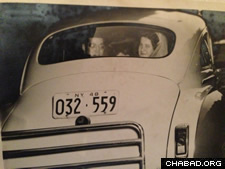
Leibel met his wife of 65 years, Ita Travis, in the spring of 1948. Her father Shlomo (also known as Sam) came from a Chabad family of Latvian origin; their original name was Rabinowitz. In 1906 oil was struck on a piece of land Shlomo had bought in Oklahoma, and the family fortune was made. In 1908, Shlomo’s sister married Rabbi Dr. Bernard Revel, the founding president of Yeshiva College (which later became Yeshiva University), and Rosh Yeshiva of Yeshivas Rabbi Yitzchak Elchanan (RIETS). The Travis family became an influential force on a national level, not only in the oil industry but in the American Jewish community.
When the match was suggested, Mordechai traveled to Chicago to meet his Ita and her parents. Evidently, he was impressed, and on his return to New York advised Leibel to go meet her in person. Before departing, Leibel sought the blessing of his Rebbe, Rabbi Yosef Yitzchak. The Rebbe responded enthusiastically: “Go, and you will be successful, Mazal Tov! Mazal Tov!” This seal of approval was more than enough for both parties; after a brief period of courtship, Leibel and Ita were married on June 20, 1948.
The young couple first lived in Borough Park, Brooklyn. Leibel dabbled in diamond-cutting and worked in his father’s office. Although he didn’t live in Crown Heights, he maintained a strong connection with the Rebbe, Rabbi Yosef Yitzchak, and with his son-in-law, Rabbi Menachem Mendel. As is well known, the Rebbe had instructed his son-in-law to lead a Chassidic gathering on the last Shabbat of each month (Shabbat Mevarachim). On these occasions, Leibel would pray at a local Borough Park synagogue, return home to make kiddush for his wife and then walk to Crown Heights to hear Rabbi Menachem Mendel speak. On the way home, he would sometimes accompany Rabbi Menachem Mendel as far as his house on President Street.
The passing of Rabbi Yosef Yitzchak on Jan. 28, 1950, was a traumatic moment for Leibel. In an interview he gave some 60 years later, he choked up when asked to recount what happened. At the time, Leibel had been in Manhattan, where he, his wife and his young son were spending Shabbat in his parents’ home. The news didn’t reach them until after Shabbat. Leibel rushed to 770, where he spent the night; the funeral was held the next morning.
Less than two months later, Leibel wrote a note of supplication (pidyon nefesh) addressed to Rabbi Menachem Mendel, and thus requesting that he accept to be Rabbi Yosef Yitzchak’s successor as Rebbe. At the time, Rabbi Menachem Mendel was steadfastly refusing to accept that he was worthy of such a role, and Leibel prepared himself to remain resolute in the face of the Rebbe’s rebuff. When he entered the Rebbe’s office and extended his hand holding the note, the Rebbe responded with incredulity, “Leibel, have you, too, gone mad?” Leibel was unfazed, “I didn’t laugh, I didn’t answer, I just held my hand out, to hand him the pidyon nefesh. He tried a few other sentences, trying to make me smile or laugh, but I was prepared for that. I would not smile, I would not laugh, I just stood there … and handed it to the Rebbe. In the end he said, ‘Nu! Let it be as you say,’ and he took the note.”
In 1954, the Bistritzky family moved to Vineland, N.J., the New Jersey Jewish farm belt. The area had seen a large influx of Holocaust survivors, and was a growing center of rural Jewish life and agriculture. The Bistritskys operated a poultry farm, raising chickens for the kosher market. Reb Leibel also ran a wholesale service, bringing pre-packed kosher chickens, along with kosher milk and various cheese products, to Jewish communities across New Jersey and Pennsylvania.
In those days, such products were not readily available outside the central Jewish communities in cities like New York and Chicago, and so his customers appreciated the service he provided. For the isolated communities that he visited, he was also more than a purveyor of kosher foodstuffs; he was a supplier of spiritual sustenance.
Rabbi Aaron Rakeffet-Rothkoff served as a rabbi in Bala Cynwyd, Pa., from 1961 to 1962; his experiences as Reb Leibel’s customer during those years left a deep impression on him. “Reb Leibel was such a warm Jew,” he said, recalling the refrigerator truck laden with “fabulous” produce. “It wasn’t just a business,” he emphasized. “Reb Leibel always had a word of Chassidic inspiration to share.”
The Rebbe’s Blessing
As the Bistritzky family grew—and mass production began to crowd small-time farmers and tradesmen out of the kosher market—it became increasingly difficult for Reb Leibel to make ends meet. He was sometimes forced to enlist his eldest son, Levi—now approaching the age of Bar Mitzvah—to help with the deliveries. On other occasions, he would leave home early in the week and not return until Shabbat. Eventually, it became too much. “I was very broken up,” Reb Leibel later remembered, “and I decided I’m going to the Rebbe.”
In accord with Chassidic custom, Reb Leibel addressed himself to the Rebbe in a written note (called a kvitel or a pidyon), which he handed to the Rebbe upon entering his office. “With a broken heart,” he recalled, “I wrote about my livelihood; I don’t know what to do … I want a brachah from the Rebbe—a blessing. The Rebbe read the whole letter, and then—still looking into the letter—he said to me, ‘Leibel, A-mighty G‑d will help you.’ ” This reassurance, however, was not enough; Reb Leibel wanted a direct commitment from the Rebbe that this would become a reality. “Rebbe,” he pleaded, citing a famous Talmudic statement, “tzadik gozer v’hakadosh baruch hu mekayem—when a righteous man makes a decree G‑d carries it out.” When the Rebbe repeated his earlier reassurance, Reb Leibel began to cry. “I will not leave here,” he said, until the Rebbe has committed himself to an unequivocal decree. “The Rebbe looked at me, and saw how I was crying, and he said ‘Nu! It should be as you say.’
“What happened in the end? I didn’t find a lottery ticket, I didn’t find a million dollars in the street, I didn’t find no nothing … But bit by bit, I clawed my way out of the hole, and I became successful. It took a long time, my wife and I worked very hard for many years till I was able to stand up on my feet … With the passing years we saw that the blessing had been fulfilled.”
An East Side Icon
In December 1961, Reb Leibel sold the farm and moved to Crown Heights with his family. He continued making the rounds, visiting customers on behalf of a dairy company called Schnalls. But in 1964 he opened a store on Manhattan’s Lower East Side that would soon become an iconic fixture of that neighborhood—Leibel Bistritzky Kosher Gourmet Foods.
More than anything else, it was Reb Leibel’s personality that made the store such a success. He and his wife greeted everyone with such sincere kindness that the store became something of a communal institution. Following the passing of Reb Leibel’s father in 1970, a new tradition began: Every day at 4 p.m., the store would close for business and open for the afternoon prayer service (minchah).
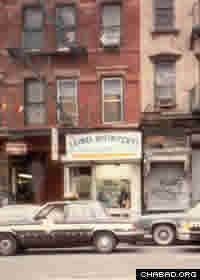
Leibel Bistritzky Kosher Gourmet Foods was an iconic fixture on Manhattan’s Lower East Side.
In a 1977 feature by The New Yorker magazine, this unusual business model was described as “a combination of free enterprise and rigid devotion,” and Reb Leibel himself was described as a “man with a soul,” who “does not believe in half measures.” His “two by nothing store,” which overflowed with variety and character, came to epitomize everything that people loved about the Jewish East Side.
Although Reb Leibel specialized in exotic cheeses and other gourmet foods, he also imported the four plant species used to fulfill the mitzvah of lulav on the festival of Sukkot. It was the Rebbe’s custom to provide sets of the four species to various distinguished guests who came to visit the Rebbe’s court during the festive month of Tishrei, and Reb Leibel soon became the Rebbe’s supplier. The personal relationship he enjoyed with the Rebbe extended to other areas as well; on Simchat Torah he would hold the Rebbe’s prayer book for him while he danced with the Sefer Torah, and when the Rebbe recited the monthly prayer sanctifying the new moon, he was one of the three people to whom the Rebbe would bless “Shalom Aleichem!” in accord with custom.
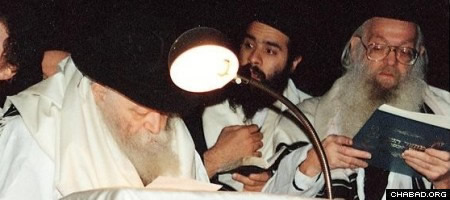
Reb Leibel with the Rebbe at the kiddush levana ceremony at the conclusion of Yom Kippur.
The Growth of Hatzalah
In 1976 a man suffered a heart attack in Crown Heights; an ambulance was called, but medical help arrived too late. Reb Leibel heard that some members of the Williamsburg Jewish community had formed a local volunteer response team to provide rapid aid in cases of such an emergency, and he decided that Crown Heights needed a similar service.
He was soon in touch with Rabbi Hershel Weber, founder of the Williamsburg Hatzalah service, who helped him purchase the necessary equipment and arrange EMT training courses. As time passed, Reb Leibel and his volunteers acquired a reputation for their professionalism and speedy medical response, and they established excellent relationships with the local hospitals and ambulance personnel.
In this capacity, Reb Leibel was also able to aid the Rebbe and the Rebbetzin on several occasions. When the Rebbe suffered a heart attack on the festival of Simchat Torah in 1977 and refused to be taken to hospital, Reb Leibel was able to borrow equipment from Brooklyn Jewish Hospital so that the doctors could monitor the Rebbe and stabilize him at the scene. The next day, one of his sons drove to New Jersey and purchased all the machinery necessary to turn the Rebbe’s office into a state-of-the-art medical center.
For several years, Hatzalah of Crown Heights did not yet have its own ambulance and was forced to use private vehicles to transport patients when necessary. In 1984, Reb Leibel organized an event to raise money to buy one, and the Rebbe gave a public talk supporting the effort. Apart from the obvious benefit of providing proper medical support at the fastest possible rate, said the Rebbe, the visible presence of an ambulance in Crown Heights would preemptively raise people’s awareness, reminding people to take precautionary steps to maintain sound health. Furthermore, he explained, the assurance that help is never far away would help them cope with a situation even before medical assistance has arrived. Accordingly, the Crown Heights Hatzalah ambulance is usually seen parked outside the main synagogue at 770 Eastern Parkway.
Hatzalah eventually grew into an international entity with chapters in every sizeable Jewish community across the globe. In addition to his work on a local level, Reb Leibel took an active role in its broader expansion, and for many years served as vice president of its central organ.
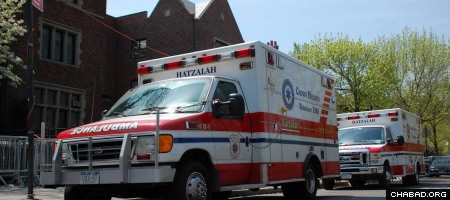
Closing the Circle
In 1996, after more than three decades as a leading figure in the Crown Heights community, Reb Leibel decided that the time had come to move to Jerusalem. He and his large family had been party to a unique period for Chabad, beginning with recovery and rejuvenation, and culminating in global expansion. Now that his children had grown up and were building their own homes, there was nothing left to tie him to Crown Heights; what had long been a dream finally became a reality.
Back in 1976, their eldest son, Rabbi Levi Bistritzky, was sent by the Rebbe as a shaliach to Safed, Israel. He served as rabbi of the Chabad community there beginning in 1979, and as chief rabbi of the city from 1993 until his untimely death in 2002. At the time, he was a prominent candidate for the role of Ashkenazi chief rabbi of Israel.
In 2003, one of Rabbi Levi’s sons, Rabbi Shlomo Bistritzky, became the Chabad rabbi in Hamburg, the city of his grandfather’s birth. Reb Leibel had vowed never again to step foot on German soil, but now he began to entertain a change of heart.
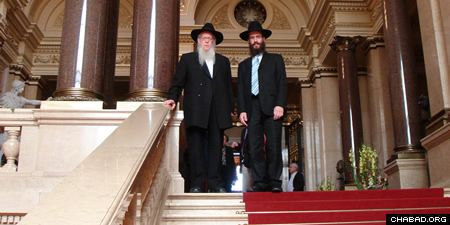
In 2006, at the age of 80, Reb Leibel returned to the city he had left so long ago to attend the opening of the Chabad community center newly built by his grandson. The participation of Reb Leibel in the ceremony was described by Berndt Röder, president of the Hamburg Parliament, as a “moving moment.” Peter Hess, the coordinator of the Stolpersteine (stumbling-block) Holocaust memorial project in Hamburg, attended the ceremony and presented Reb Leibel with two Stolpersteine bearing the names of his grandparents, Levi and Rechuma Lagovier. These were later embedded in the sidewalk outside the home where he, his parents and his grandparents had lived together at Innocentiastrasse 64.
Addressing the crowd, Shlomo repeated the words of his grandfather: “When you return to the place from which I once had to flee, and there you contribute to the ongoing expansion of Jewish life, you are providing the best possible response to the Holocaust.”
In 2012, Reb Leibel returned to Hamburg one last time to attend the appointment of his grandson as the city’s new chief rabbi.
Rabbi Yehudah Leib Bistritzky is survived by his wife, Mrs. Ita Bistritzky; siblings Rivkah Rhein (Boro Park) and Bela Katzenstein (Jerusalem, Israel); his children, Mrs. Miriam Sheindel Nelkin (Toronto, Canada), R. Yosef Yitzchok Bistritzky (Flatbush, N.Y.), R. Avraham Yisroel Bistritzky (Crown Heights, N.Y.), Mrs. Raizy Greenwald (Rehovot, Israel), Mrs. Ruchama Clapman (Five Towns, N.Y.), Mrs. Devorah Leah Cohen (Aventura, Fla.), R. Menachem Mendel Bistritzky (Five Towns, N.Y.), Rabbi Shlomo Mordechai Bistritzky (Agoura Hills, Calif.) and R. Schneur Zalman Bistritzky (New York, N.Y.); as well as by many grandchildren, great-grandchildren and great-great grandchildren.
* * *
Credits
This article incorporates information from Toldot Chabad Be-artzot Ha-brit (New York: Kehot, 1989), Kovetz Chaf-Ches Sivan (New York: Kehot, 1991), Kfar Chabad Magazine (issues 804 and 1510), The New Yorker Magazine (May 23, 1977), Juedische Allgemeine (18.05.2006), a lecture delivered by Rabbi Aaaron Rakeffet-Rothkoff (19-5-2013) and interviews with Reb Leibel himself, recorded by Jewish Educational Media (JEM).
Thanks goes to R. Schneur Zalman Bistritzky and R. Chanoch Nelkin for providing information, documents and photographs, and for helping with fact-checking.
